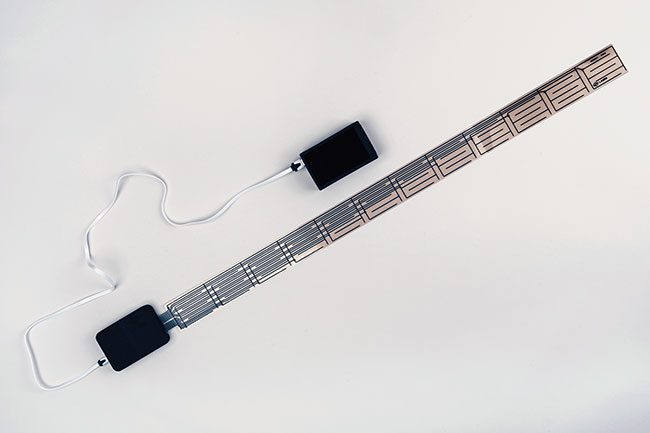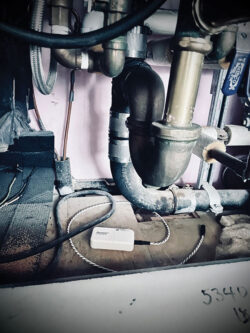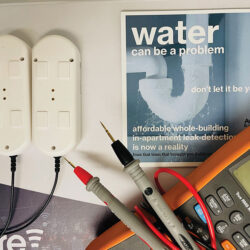
Features
Architectural design
Contracting
Fabrication
Innovations
The Internet of Facades – Wireless communication in building envelope components
Integrated wireless technology holds the key to many future needs
June 13, 2023 By Treena Hein
 Microtransmitter technology has reached the point where sensors that communicate wirelessly can be installed almost anywhere without wiring or difficult power hookups. Here’s a water-sensing “smart tape” from Laiier.
Microtransmitter technology has reached the point where sensors that communicate wirelessly can be installed almost anywhere without wiring or difficult power hookups. Here’s a water-sensing “smart tape” from Laiier. Internet of Things (IoT) technology to monitor things like appliances in the home and pumps in manufacturing plants is now well established. Without further ado, let’s take a look at IoT developments in facades and other building components.
The potential exists for wireless sensor systems to be installed in the building facade, monitoring conditions like air pressure, electrical resistance, moisture and temperature and reporting leaks to maintenance teams as needed. Research models have been created exploring the many applications. At least one major European glazier is already using sensors to detect the rate of heat loss in different areas. Future installations could compare the performance of two different types of facades or glass in different buildings in terms of heat or acoustics.
Let’s first look at “Comparative Analysis of Technologies Used in Responsive Building Facades,” published by a team including Negar Heidari Matin, director and founder of the new Oklahoma University High Performance Interior Architecture
Laboratory (an interdisciplinary research team spanning interior architecture, building science and advanced building technology). In the analysis, scientists note that facade sensor setups could have central or decentralized sensors and could also include material sensors. When asked for an example, Matin notes that some types of smart glass “can detect moisture and unacceptable temperature changes.” Also known as switchable glass, dynamic glass and smart-tinting glass, smart glass is able to change its reflective properties to darken and prevent sunlight and heat from entering a building and also provide privacy. Active smart glass technologies include electrochromic, liquid crystal and suspended particle. Passive versions include thermochromic and photochromic technologies.
In a study from Italy called “A Sub-Zonal PMV-Based HVAC and Facade Control System for Curtain Wall Buildings,” the team created an experimental test room in a building with curtainwall where infra-red sensors were used to measure and separately control different sub-zones of a room to regulate the heating, cooling and light level. A new facade module was developed to integrate sensors and actuators, with dedicated housing for hardware and cabling. The modules were composed of double pane windows and aluminum frame with thermal break. The overall control system included a distributed sensors and actuators network, also embedded into the facade modules, to measure indoor and outdoor parameters and to regulate fan-coils, windows opening and shadings with a sub-zonal approach.
Last year, a group of scientists in China published a study where optical fiber sensors were used successfully to monitor and analyze curtainwall deformation that can occur over time due to aging materials, corrosion and loosening of fasteners. Sensors based on fiber optics provide excellent sensing performance and can function in remote and harsh environments. They are also cost-effective, very small (the size of a human hair), lightweight and immune to electromagnetic interference.
A close look at sensors
Jerry Kestenbaum, founder and CEO of New York-based Aware Buildings, provides his thoughts about how sensors could be placed inside facades. Aware Buildings employs mostly water leak but also other types of IoT sensors (temperature, humidity, air quality, acoustic) to alert building managers so they can act quickly to deal with issues.

Leak-detection technology has become incredibly sensitive and convenient thanks to sensors like this that communicate with smart phone apps, probably saving millions in damage in commercial buildings every year. But sensors can grab lots of other data too on things like temperature, frame deflection and humidity.
Kestenbaum first notes that today’s sensors can be programmed to take readings and report in a wide variety of ways. “They can do whatever you like,” he says. “They can detect and report on a full range of data or just specific data at chosen intervals. They can take readings and relay them all or only relay when the reading is outside of range, known as anomaly reporting.
To confirm that it’s a real and significant anomaly and not just a momentary fluctuation of site conditions, the sensor can be set to do edge detection algorithms, such as gathering an average of several readings over a short interval and acting on the resulting average anomaly. There is skill in designing sensors that do edge computing and alerting, though. Kestenbaum adds that if you only have the system set for anomaly readings, you also need the sensor to regularly relay a proof-of-life: a heartbeat reading, as it’s called, to show it’s still working and still connected to your systems.
Looking at how wireless sensors would function in facades, Kestenbaum notes that they would need to relay signals over distances but also may have to penetrate through various building materials, which means the signal must be stronger while at the same time not drawing excess battery energy. ”We watch new developments closely in terms of power and range and redundancy, and there has been great progress,” he says. “There’s a range of technologies that have been tried. In terms of distance, with the right ones you can now achieve distances from a hub to wireless sensors of hundreds of feet and often across several vertical floors, especially in open spaces like a floor in a commercial building.”
Advances have also been made in batteries and power consumption. “We use specialized long-life batteries that last over 10 years,” says Kestenbaum. “Sensor components can be selected that use very little power, such as those that measure for temperature and humidity. And the technology has become very smart about sleep cycles that can be engineered into the sensor firmware, which means they only use power when programmed to wake up and take a reading.”
However, at some point, any sensor attached to or within a facade could require servicing or fresh batteries. Because the sensor could be installed out of arm reach, you’d need a way to take the sensor out of its bracket, bring it to the maintenance person for a battery change and place it back. “I think the best approach would be to outfit the sensor with a magnet and use a magnetic snaking tool for remote grabbing,” Kestenbaum says. “If needed, you’d include a very inexpensive scoping camera on a wire with a light to the end of the grabber in order to see what you are doing.”
Kestenbaum also notes that power-over-ethernet (PoE) could be used to power facade sensors instead of batteries. It’s a method of providing both power and networking to a device via data network cabling, and very suited to powering low- to medium-power devices that can make use of both power and connectivity in a single cable. PoE can power sensors even 1,000 feet away.
Targeting moisture
Wireless printed sensors and sensor cables could be used in facades to detect moisture at the seams and are indeed designed to detect very, very small amounts of moisture. For example, Laiier offers its Severn sensor array printed using Henkel conductive ink that can detect as little as two drops of water. These types of sensors are also made by companies such as Alliot, AKCP and Alta. As stated in a Laiier company blog entry, “sensors like this cover a specific area where leaking might occur. This might include roofs, flooring and in and around the pipe infrastructure of your building. Printed sensors have a thin, flexible form factor, often using adhesives so they can be easily installed in any size or shape. Sensor cables achieve a similar goal, albeit with less flexibility. As the name suggests, they enable you to install different sensors in hard-to-reach places by cable.”

Power supply is one concern when it comes to integrating sensors into facades. Designing with access to batteries in mind may be necessary.
In December, Laiier announced a partnership with Henkel to develop more novel printed electronics and enable more use of Laiier´s Severn water leak detector in commercial and industrial buildings. Henkel’s range of Loctite inks for printing electronics include silver, carbon, dielectric and other non-conductive inks, as well as silver/silver chloride inks. Beyond water detection sensors, the company’s inks are also suitable for a wide variety of sensor technologies, including self-regulating heating, pressure sensing or printed antennas. The Severn water leak detector is the world’s first smart tape and combines printed carbon and dielectric inks from Henkel with electronic hardware and digital services. It’s thin, conformable, self-adherent and designed to work throughout the building envelope. The tape is easy to install by an untrained professional, applicable to various surfaces and highly sensitive with a large coverage area. The sensors are split into multiple sensing zones in order to identify the precise location of a leak.
In the coming world of increased demand for data acquisition from building facades, glass and metal fabricators will need to become familiar with integrating sensor technology into their designs. Italian fabricator Permasteelia now uses RFID transmitters in all its installations.
Print this page
Leave a Reply